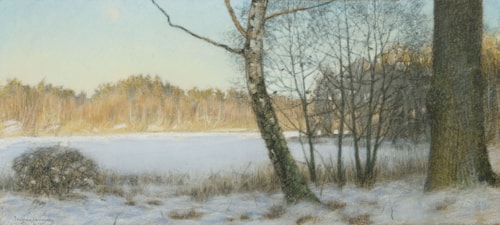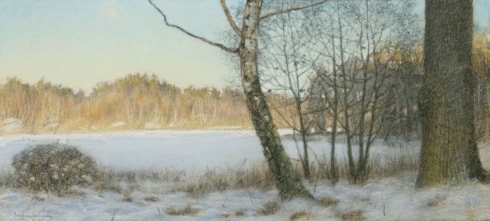
Eugène JANSSON
Stockholm 1862 - Skara 1915
Biography
The Swedish painter Eugène Jansson suffered an attack of scarlet fever as a child which left him with health issues for the rest of his life, including poor eyesight and chronic kidney issues. He trained as an artist in Stockholm, at both the Tekniska skolan (Technical School) and at the private art school run by the painter Edvard Perséus, before being admitted into the Royal Swedish Academy of Arts in 1881. His earliest work was made up of family portraits and still-life compositions. Unlike many of his fellow students, he lacked the financial resources to travel to Paris to complete his artistic education. In 1886 Jansson joined the newly-formed Swedish Artist’s Union, the Konstnärsförbundet, of which he became the secretary and with which he remained closely involved throughout his career. The artist, who lived in Stockholm all his life, soon began to develop a particular speciality in views of the city and its surroundings, often at night. Jansson lived, with his mother and brother, in an apartment in the heights of Södermalm, the southern district of Stockholm, with a view over Riddarfjärden bay and the central part of the city beyond. Most of his paintings of the period between the early 1890s and 1904 were views over Riddarfjärden, seen from his home, or twilight street scenes in Södermalm, all characterized by a distinctive bluish tonality. (Indeed, Jansson was sometimes called the blåmåleren, or ‘the blue painter’.) The influence of the Norwegian painter Edvard Munch, who was the subject of a major exhibition in Stockholm in 1894, is also evident in many of Jansson’s urban views. Among the artist’s patrons was the collector Ernest Thiel, who acquired several of his works and sponsored study trips to Paris in 1900 and to Italy and Germany in 1901.
Around 1904, however, Jansson confessed to a friend that he wanted to stop painting the nocturnal, atmospheric views of Stockholm that had dominated his output until then, and which had brought him some success. He gave up participating in exhibitions for a number of years, and in the last decade of his life moved away from landscape painting and began instead to produce portraits and figural works, mainly paintings of male nudes. (Apparently, Jansson once told the painter, art collector and patron Prince Eugen Nicolaus, the son of the Swedish King, that he had always wished to be a figure painter, but could not afford the models’ fees.) The artist, who always suffered from poor health, had taken up swimming and winter bathing, and he found new subjects for his paintings in the Swedish Navy’s cold-water bath houses on the island of Skeppsholmen in Stockholm. Using volunteer models from the Navy, he began producing large-scale canvases of young men exercising, performing gymnastics or lifting weights. Perhaps because of the nature of these nude subjects, Jansson did not exhibit them in public until 1907. From 1911 onwards he maintained a studio near the military buildings in Skeppsholmen, and several of his paintings of athletic male nudes were exhibited at the Konstnärsförbundet during the Summer Olympics in Stockholm in 1912. The artist died of a cerebral haemorrhage in 1915, and three years later a commemorative exhibition of his work was held at the Liljevalchs Konsthall in Stockholm.
Although his work was best known for many years only in his native Sweden, in recent years Jansson’s oeuvre has come to wider international attention. A number of his paintings were included in the groundbreaking exhibition Northern Light: Realism and Symbolism in Scandinavian Painting 1880-1910, shown at three American museums between 1982 and 1983, as well as in the exhibition Luminous Modernism: Scandinavian Art Comes to America in New York in 2011-2012, while Jansson was the subject of a monographic exhibition at the Musée d’Orsay in Paris in 1999.


